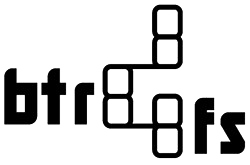Btrfs
Updated: 08/02/2020 by Computer Hope

Btrfs is a copy-on-write B-tree file system with enhanced performance, fault tolerance, data repair, and administration features. It was created at Oracle in 2007 for Linux.
Btrfs features
Btrfs is similar to ZFS in that it is a copy-on-write file system. Duplicated (copied) data is not written to disk unless it is modified. Unlike ZFS, which writes data to blocks, Btrfs maintains a record of "data extents," permitting efficient packing of small files.
Other features include:
- Maximum volume size of 16 exbibytes.
- Maximum of 264 files.
- Multi-device spanning and storage pooling.
- Checksums of data and metadata.
- Automatic online defragmentation and background error correction (scrubbing).
- Online resizing of volumes.
- In-place conversion to and from ext2/3/4 and reiserfs file systems.
- Transparent data compression.
- Subvolumes, where a partition can have multiple, separately mountable root directories.
- Incremental backup.
- Support for RAID (redundant array of independent disks) levels 0, 1, and 10.
- POSIX (portable operating system interface for Unix) attributes and permissions, ACLs, and extended attributes.
- Out-of-band (post-process) data deduplication.
Operating system support
Btrfs is supported by Linux operating systems (including Android), and by ReactOS.
